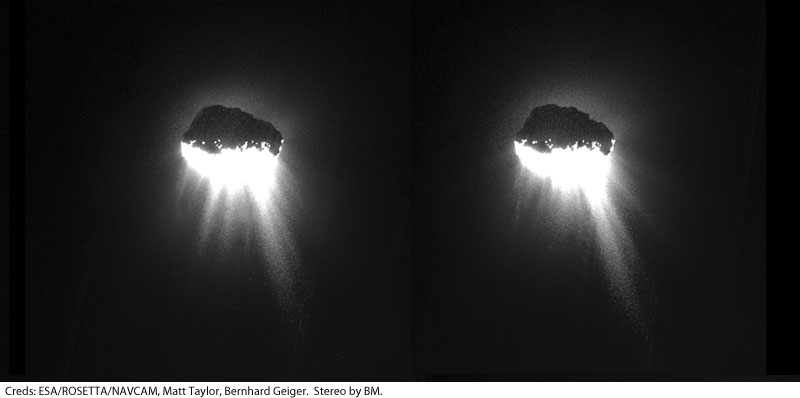Free-view this parallel stereo image (help is here www.londonstereo.com/stereophotography.html) or view it in your patent London Stereoscopic Company OWL stereoscope ! (link here www.londonstereo.com/shop_home3.html).

This pair of images was kindly thrown to me by Rosetta mission boss Matt Taylor himself (and colleague Bernhard Geiger) – as a challenge, I guess !
Unlike the last Rosetta stereo on this Soapbox, derived from the very high quality Narrow Angle Camera of the Osiris science instrument, this time we’re looking at the output of Rosetta’s wider angle navigation camera – and there was some noise and disturbance to deal with – but this is an unusual view of Comet 67P. From this angle, as the amazing Rosetta probe, directed from ESA Rosetta Mission Control on Earth, passes along a trajectory some 208 miles from the comet, we see the comet ‘top down’, and it looks like a burning cinder in the sky. Of course it’s not burning, but this is close to the warmest it will get in this orbit, around +30 or so degrees Centigrade, since it’s close to its Perihelion (13th August), seen on August 8th, around a month ago. We’re looking at a side-on view of the sunlit part of the object, also giving us a view of the dark side of the comet. The unlit portion of the comet’s surface is very dark, and we wouldn’t see it at all except for the fact that it’s silhouetted against part of the dusty coma. With the magic of 3-D, however, now that these two images are suitably aligned, we can clearly make out the C67P’s three-dimensional shape, its two ‘lobes’ one behind the other in our line of sight. There’s also evidence here for the ever-changing pattern in the eruptions from its surface as it warms up. Left of centre we can see a jet in the left image ‘flashing’ in our three-dimensional view, indicating that a jet was present when the left hand image was captured, but not the right.
The times logged for the two component images are
2015 08 12 T 09 05 03
and 2015 08 12 T 09 24 52
So about 20 minutes between these exposures. At its speed in the comet’s frame of reference of around 2 miles per hour, in this time it’s covered about two thirds of a mile, and so this is the baseline of this stereo pair. My sincere thanks to Matt for making this account scientifically bullet-proof.
Cheers
Bri
PLEASE OBSERVE COPYRIGHT
© brianmay.com